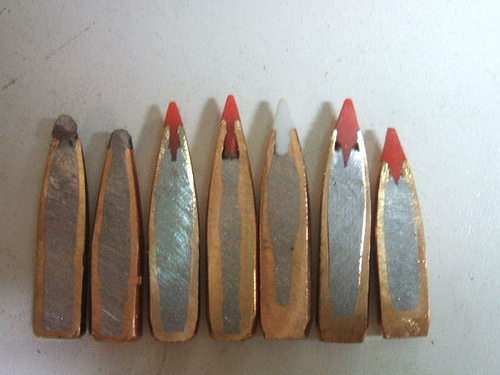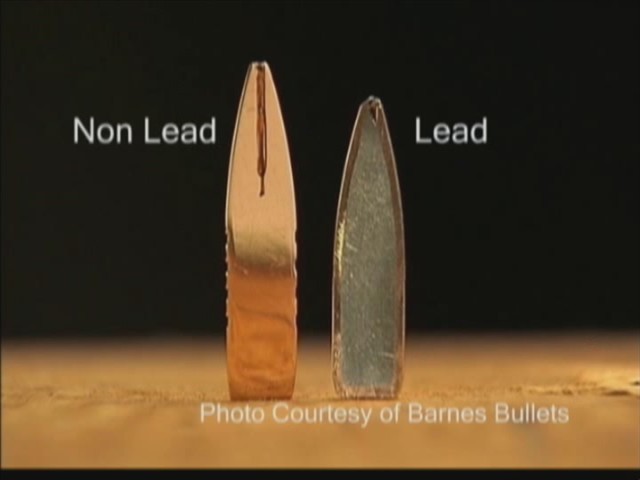I got into a discussion yesterday with one of my hunting buddies that stopped by and we got to discussing the fact that while most experienced hunter's eventually come through field experience to understand that longer and heavier bullet designs on average do tend to penetrate deeper than the faster and lighter projectiles, the current change to the non-lead core design projectiles makes the comparison rather difficult, between the two totally different designs.
sectional density is a way of mathematically defining a bullets weight to length factor
Sectional density (a bullet's weight in pounds divided by its diameter squared) describes a bullet's length for its diameter: The higher the number, the longer the bullet. Generally speaking, the larger a bullet's sectional density, the deeper it will penetrate.
http://www.speer-bullets.com/products/rifle/hunting/hot_cor.aspx
http://www.hornady.com/bullets/rifle
and while it should be obvious each manufacturer will be fully aware of what his product is designed to do and where it will be best used yet as a occasional hunting guide I still see guys grab several boxes of what ever ammo Walmart has on sale in their particular caliber and assume it will work and few even bother to sight in with new ammo they buy
as a general rule selecting a jacketed projectile in the caliber of your choice that falls in the 240-300 sectional density range will generally place your choice in the big game range with those bullets close to .230 for light game like deer and those closer to .300 best designed for moose, bear etc.
longer heavier bullets can be more aerodynamic and have less aerodynamic drag ,allowing them to carry more remaining inertial energy to a target, thats why a heavier bullet starting at a lower velocity, than a lighter and faster bullet, can in some cases hit significantly harder and penetrate deeper at longer ranges.
READ THE LABEL, ON ALL AMMO,DO FIVE MINUTES RESEARCH and SIGHT IN YOUR RIFLE,YOU MIGHT BE AMAZED AT THE DIFFERENCES
http://garage.grumpysperformance.com/index.php?threads/printable-targets-and-sighting-in.4560/
if your choice falls lower , like a 150 grain in a 308 (use calculator below)its going to be on average faster and penetrating a bit less than ideal from some angles
if your choice falls higher , like a 220 grain in a 308 (use calculator below)its going to be on average slower and penetrating a bit more than ideal and opening slower as it passes through from some angles
the formula for kinetic energy here is
bullet weight in grains x velocity in fps x velocity in fps/450240=energy
example
a common 30/06 load for deer
150 grain bullet x 3000 fps x 3000 fps /450240=2998 ft lbs
a common 30/06 load for elk
180 grain bullet 2720 fps x 2720 fps/450240=2957 ft lbs
while the energy levels are similar the results are very different, as the lighter projectile works best only on lung shots the heavier will more reliably break shoulders
in the past a 30 caliber 150-165 cup and core bullet design was a very common
 the denser or heavier a projectile can be made the more efficiently it can be designed to reduce air resistance by reducing its diameter while still allowing its mass to carry inertial energy , lead/tin alloys were found to be almost ideal until smokeless powder forced the used of a jacket or guilding metal, copper nickle jacket to reduce the rifling from fouling excessively as velocities exceeded about 1900 fps and kept climbing, gold is too expensive and depleted uranium has other qualities that make it less useful for a hunting projectile for mass use at low price.
the denser or heavier a projectile can be made the more efficiently it can be designed to reduce air resistance by reducing its diameter while still allowing its mass to carry inertial energy , lead/tin alloys were found to be almost ideal until smokeless powder forced the used of a jacket or guilding metal, copper nickle jacket to reduce the rifling from fouling excessively as velocities exceeded about 1900 fps and kept climbing, gold is too expensive and depleted uranium has other qualities that make it less useful for a hunting projectile for mass use at low price.


http://www.chuckhawks.com/sd.htm
Sectional Density Calculator
http://www.beartoothbullets.com/rescources/calculators/php/density.htm
http://www.hornady.com/ballistics-resource/external
bullet stability and twist rates
http://www.jbmballistics.com/cgi-bin/jbmstab-5.1.cgi
ballistic calculator
http://www.hornady.com/ballistics-resource/ballistics-calculator
sectional density is a way of mathematically defining a bullets weight to length factor
Sectional density (a bullet's weight in pounds divided by its diameter squared) describes a bullet's length for its diameter: The higher the number, the longer the bullet. Generally speaking, the larger a bullet's sectional density, the deeper it will penetrate.
http://www.speer-bullets.com/products/rifle/hunting/hot_cor.aspx
http://www.hornady.com/bullets/rifle
as a general rule selecting a jacketed projectile in the caliber of your choice that falls in the 240-300 sectional density range will generally place your choice in the big game range with those bullets close to .230 for light game like deer and those closer to .300 best designed for moose, bear etc.
longer heavier bullets can be more aerodynamic and have less aerodynamic drag ,allowing them to carry more remaining inertial energy to a target, thats why a heavier bullet starting at a lower velocity, than a lighter and faster bullet, can in some cases hit significantly harder and penetrate deeper at longer ranges.
READ THE LABEL, ON ALL AMMO,DO FIVE MINUTES RESEARCH and SIGHT IN YOUR RIFLE,YOU MIGHT BE AMAZED AT THE DIFFERENCES
http://garage.grumpysperformance.com/index.php?threads/printable-targets-and-sighting-in.4560/
if your choice falls lower , like a 150 grain in a 308 (use calculator below)its going to be on average faster and penetrating a bit less than ideal from some angles
if your choice falls higher , like a 220 grain in a 308 (use calculator below)its going to be on average slower and penetrating a bit more than ideal and opening slower as it passes through from some angles
the formula for kinetic energy here is
bullet weight in grains x velocity in fps x velocity in fps/450240=energy
example
a common 30/06 load for deer
150 grain bullet x 3000 fps x 3000 fps /450240=2998 ft lbs
a common 30/06 load for elk
180 grain bullet 2720 fps x 2720 fps/450240=2957 ft lbs
while the energy levels are similar the results are very different, as the lighter projectile works best only on lung shots the heavier will more reliably break shoulders
in the past a 30 caliber 150-165 cup and core bullet design was a very common



http://www.chuckhawks.com/sd.htm
Sectional Density Calculator
http://www.beartoothbullets.com/rescources/calculators/php/density.htm
http://www.hornady.com/ballistics-resource/external
bullet stability and twist rates
http://www.jbmballistics.com/cgi-bin/jbmstab-5.1.cgi
ballistic calculator
http://www.hornady.com/ballistics-resource/ballistics-calculator
Last edited:
